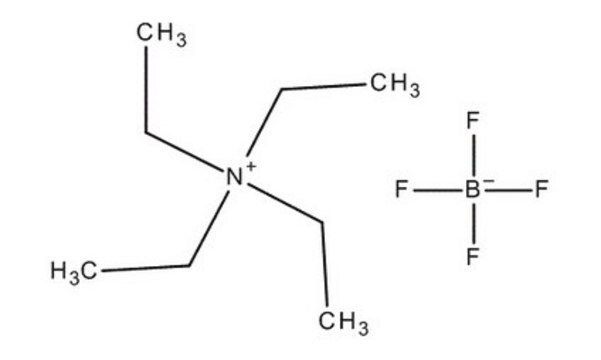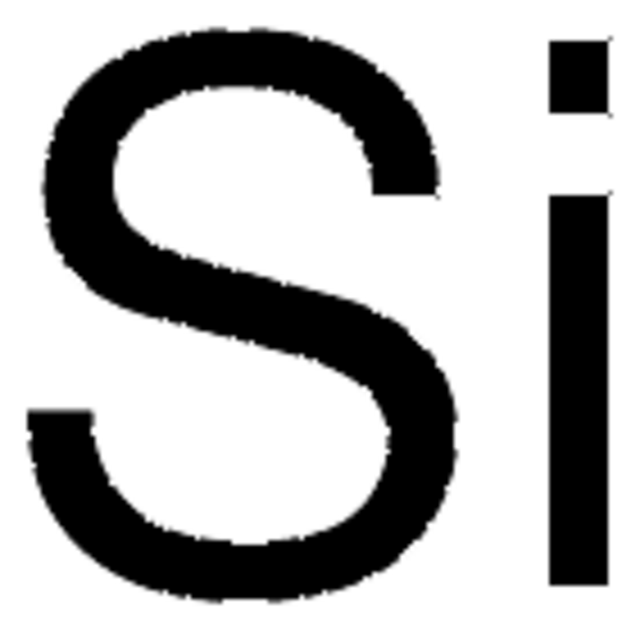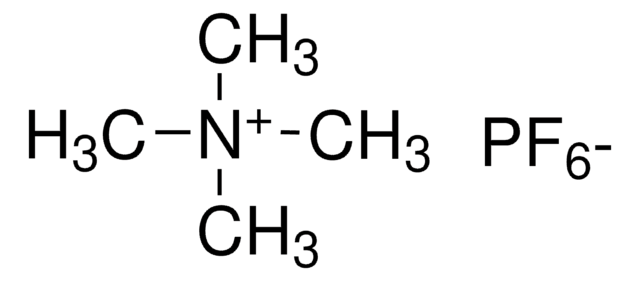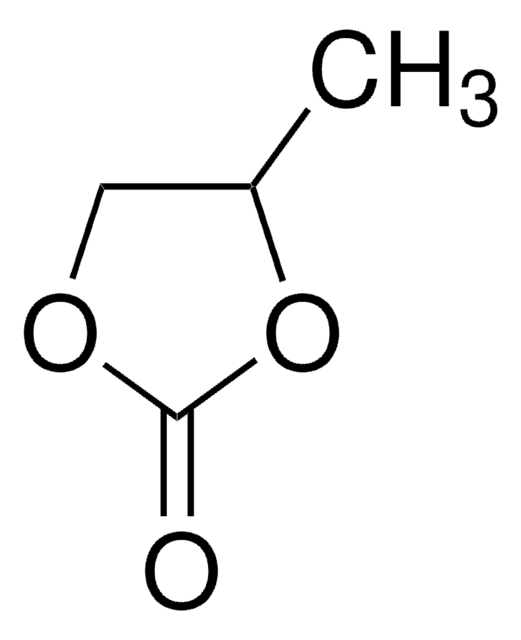86618
Tetraethylammonium-tetrafluoroborat
for electrochemical analysis, ≥99.0%
About This Item
Empfohlene Produkte
Qualität
for electrochemical analysis
Qualitätsniveau
Assay
≥99.0% (T)
≥99.0%
Form
crystals
mp (Schmelzpunkt)
≥300 °C (lit.)
Löslichkeit
acetonitrile: 0.1 g/mL, clear, colorless
SMILES String
F[B-](F)(F)F.CC[N+](CC)(CC)CC
InChI
1S/C8H20N.BF4/c1-5-9(6-2,7-3)8-4;2-1(3,4)5/h5-8H2,1-4H3;/q+1;-1
InChIKey
XJRAKUDXACGCHA-UHFFFAOYSA-N
Suchen Sie nach ähnlichen Produkten? Aufrufen Leitfaden zum Produktvergleich
Verwandte Kategorien
Allgemeine Beschreibung
Anwendung
- High-rate electrochemical capacitors based on ordered mesoporous silicon carbide-derived carbon: This study discusses the use of Tetraethylammonium tetrafluoroborate in enhancing the performance of high-rate electrochemical capacitors, focusing on ordered mesoporous silicon carbide-derived carbon structures (Korenblit et al., 2010).
- Exactly matched pore size for the intercalation of electrolyte ions determined using the tunable swelling of graphite oxide in supercapacitor electrodes: The application of Tetraethylammonium tetrafluoroborate in electrolyte solutions for supercapacitors, demonstrating how it facilitates the exact matching of pore sizes in graphite oxide electrodes for optimal ion intercalation (Sun et al., 2018).
- A universal model for nanoporous carbon supercapacitors applicable to diverse pore regimes, carbon materials, and electrolytes: Describes a modeling approach that incorporates the characteristics of Tetraethylammonium tetrafluoroborate in various carbon materials and electrolytes, enhancing the understanding and design of supercapacitors (Huang et al., 2008).
- Sub-micrometer Novolac-Derived Carbon Beads for High Performance Supercapacitors and Redox Electrolyte Energy Storage: Research on utilizing Tetraethylammonium tetrafluoroborate in novel sub-micrometer novolac-derived carbon beads, which significantly boost the efficiency and energy storage capacity of supercapacitors (Krüner et al., 2016).
- Biomass-based Hierarchical Porous Carbon for Supercapacitors: Effect of Aqueous and Organic Electrolytes on the Electrochemical Performance: Explores the efficacy of Tetraethylammonium tetrafluoroborate in enhancing the electrochemical performance of biomass-derived hierarchical porous carbons in various electrolyte environments (Chen et al., 2019).
Sonstige Hinweise
Signalwort
Warning
Gefahreneinstufungen
Acute Tox. 4 Dermal - Acute Tox. 4 Inhalation - Acute Tox. 4 Oral - Eye Irrit. 2 - Skin Irrit. 2 - STOT SE 3
Zielorgane
Respiratory system
Lagerklassenschlüssel
11 - Combustible Solids
WGK
WGK 3
Flammpunkt (°F)
Not applicable
Flammpunkt (°C)
Not applicable
Persönliche Schutzausrüstung
dust mask type N95 (US), Eyeshields, Gloves
Hier finden Sie alle aktuellen Versionen:
Besitzen Sie dieses Produkt bereits?
In der Dokumentenbibliothek finden Sie die Dokumentation zu den Produkten, die Sie kürzlich erworben haben.
Kunden haben sich ebenfalls angesehen
Unser Team von Wissenschaftlern verfügt über Erfahrung in allen Forschungsbereichen einschließlich Life Science, Materialwissenschaften, chemischer Synthese, Chromatographie, Analytik und vielen mehr..
Setzen Sie sich mit dem technischen Dienst in Verbindung.











